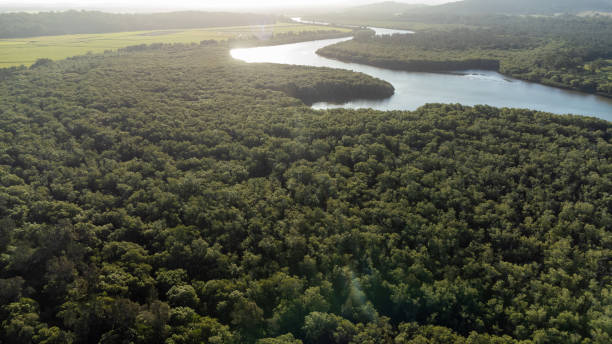By Matt Wisnieff
The Kerry-Lieberman (KL) bill details a plan for United States participation in international climate change efforts in Title V, §§ 5001-5007, which begins on page 893. These provisions recognize that widespread social, political, economic, cultural, and environmental challenges are posed by climate change—particularly to developing countries—that imperil the environmental, economic, national security, and foreign policy interests of the United States. To address these challenges, the bill contains numerous mechanisms for providing support to developing nations and promoting the development and use of environmentally friendly technologies.
Policies
The KL bill outlines several policy points that are to serve as focus areas for the bill’s international climate efforts. Generally, it is the policy of the United States “to recognize that global climate change is a potentially significant national and global security threat multiplier; is likely to exacerbate competition and conflict over agricultural, vegetative, marine, and water resources; and will likely result in increased displacement of people, poverty, and hunger within developing countries.” (§ 5001(1)(A-C))
The bill would also recognize that there are disproportionate impacts on developing countries, that have a reduced capacity to respond to the impacts of climate change, and that are likely to pose “long-term challenges to the national security, foreign policy, and economic interests of the United States.” (§ 5001)(3)(B))
The bill also seeks “to mitigate climate change” through deforestation reduction efforts, deployment of clean energy technologies through bilateral and multilateral financing agreements, and by providing financial assistance to developing countries. (§ 5001(5-10))
Finally, KL would recognize the United Nations Framework Convention on Climate Change as a “primary forum” for agreement on global climate change. (§ 5001(11))
International Programs
Title V contains two significant administrative elements. The first is contained in § 5003, entitled, “Strategic Interagency Board on International Climate Investment.” This section provides for the establishment of an eponymous institution by the President not later than 90 days following the enactment of the KL bill. The Board is to consist of the Secretary of State, who is to serve as chairperson; the Administrator of the United States Agency for International Development (USAID); the Secretary of Energy; the Secretary of the Treasury; the Secretary of Commerce; the Administrator of the EPA; the Secretary of Agriculture; and any other relevant official the President may designate for membership on the Board.
The Board is tasked with “assessing, monitoring, and evaluating the progress and contributions of relevant departments and agencies of the Federal Government in supporting financing for international climate change activities.” (§ 5003(b))
The Board is also required to provide annual reports of the actions taken by Federal agencies and their effectiveness. In addition, every three years, the Board is required to cooperate with the National Academy of Sciences to produce a review on global needs and opportunities for climate change investment in developing countries. (§ 5006(b))
The second major administrative institution established by Title V is the “International Climate Change Adaptation and Global Security Program,” which, under § 5005(a), is to be formed by the Secretary of State in consultation with the Administrator of USAID, the Secretary of the Treasury, the Administrator of the EPA, the Secretary of Commerce, and the Secretary of Agriculture. The purpose of this institution is to supplement existing bilateral assistance, multilateral funds and international institutions pursuant to the United Nations Framework Convention on Climate Change. No more than 60 percent and no less than 40 percent of the assistance available for the Program is to be committed to one or more eligible multilateral funds or international institutions.
The Secretary of State is to have oversight responsibility for the distribution of assistance to multilateral funds and international institutions, while the Administrator of USAID, in consultation with the Secretary, is to have oversight responsibilities for bilateral assistance agreements. (§ 5005(e)(1-2)) For the purpose of providing the Administrator of USAID with the authority necessary to carry out his responsibilities under KL with respect to bilateral assistance agreements, the administrative authorities under the Foreign Assistance Act of 1961 (22 U.S.C. 2151 et seq.) are to “apply to the implementations of [KL] to the same extent and in the same manner as the authorities apply to the implementation [of the Foreign Assistance] Act” except to the extent that it is inconsistent with the provisions of KL. (§ 5005(f)(1))
These programs represent the KL bill’s general attitude toward international participation in climate change efforts, which is focused on bilateral/multilateral action within the framework of a U.S. treaty or the United Nations, usually with a U.S. agency overseeing the program. For example, under KL, the distribution and management of international offset credits is to be monitored by the International Offsets Integrity Advisory Committee, which would observe and recommend to multiple agencies appropriate action to achieve U.S. international climate change goals. (§ 2001, amending the Clean Air Act to include Title VII, Part E, § 751-2) Meanwhile, the operative mechanisms often remain under the direct supervision of administrative officers, such as the Administrators of the EPA or USAID.
Reduction of International Deforestation
Not later than 2 years after the enactment of KL, the Administrator of USAID, in consultation with the Administrator of the EPA and the Secretary of Agriculture, are to establish a program to provide assistance to developing countries to reduce greenhouse gas emissions resulting from deforestation. KL aims to achieve an emissions reduction of at least “720,000,000 of carbon dioxide equivalent in 2020, a cumulative amount of at least 6,000,000,000 tons of carbon dioxide equivalent by December 31, 2025, and additional emissions reductions in subsequent years.” (§ 5004(b)(1)) The bill also seeks to equip developing nations with the knowledge and incentives needed to reduce deforestation on a national level. The bill aims to accomplish this by (1) preparing developing nations for participation in international offset programs, (2) preserving existing carbon stocks where forest carbon is vulnerable to leakage, and (3) building the scientific knowledge and institutional capacity of eligible developing nations to conserve their forests and monitor the impacts of climate change.
Funding for International Programs
Funding for the International Climate Change Adaptation and Global Security Program is to be authorized for such amounts “as are necessary.” (§ 5005(i)) Likewise, funding is authorized for the international deforestation reduction provisions by § 5004(m), for “such sums as are necessary.”
For the purposes of managing the International Climate Change Adaptation and Global Security Program, USAID may not use more than 7 percent of the funds allocated for the Program for its administrative expenses in support of the Program’s activities. This allocation of funds is to be in addition to other allocations of funding made available for the same purposes. Finally, necessary appropriations are also authorized for the Program under § 5005(i).
Clean Technology Transfer
While the KL bill recognizes the possibility of clean technology transfers as an important policy point, which must “be cost-effective; enhance economic opportunities for the United States; increase the demand for clean energy products; lower costs; and result in global greenhouse gas emissions reductions,” (§ 5001(7)(C)(i-v)) it also recognizes numerous difficulties in actually enacting them. Some difficulties arise regarding international and domestic intellectual property laws, and KL therefore affirms that “intellectual property rights are a key driver of investment and research and development in, and the global development of, clean technologies.” (§ 5001(D)) While recognized in KL as a policy goal, clean energy technology transfer does not seem to be the focus of the bill, and KL does not include new administrative tools or mechanisms for that purpose.
Comparison with International Efforts in Waxman-Markey (WM)
Where the KL bill’s international climate change efforts are organized around 11 principles, the WM bill is organized around nine significant “findings” contained in Title IV, Subtitle E, Part 2, § 491. These findings are largely similar to KL’s general policies described in § 5001. In particular, they recognize that global climate change poses long-term “strategic, social, political, economic, cultural, and environmental” problems, which disproportionately affect developing nations.
However, where KL recognizes the United Nations Framework Convention on Climate Change (UNFCCC) as a “primary forum,” the WM bill merely reaffirms the United States’ commitment “to assist” developing nations under the UNFCCC. (§ 491(a)(8-9)) WM’s findings section also leads into a “purposes” section, which outlines two major policy goals: (1) providing “new and additional” assistance to developing nations vulnerable to climate change, and (2) protect and promote the national security, foreign policy, environmental and economic interests of the United States. Despite the change in structure, these “findings” and purposes” are not substantially different from KL’s general policies—KL § 5005(h)(2) provides that funds for climate change adaptation efforts are to be made “in addition” to other funds available for the same purpose.
The operative segment of the WM bill’s international efforts portion is § 493, which creates an “International Climate Change Adaptation Program.” Under § 493, the Secretary of State, together with the Administrator of USAID, the Secretary of the Treasury, and the Administrator of the Environmental Protection Agency, are to form and manage the Program, which is to be carried out via the distribution emission allowances to eligible international funds and institutions. These allowances are to be distributed, (1) in the form of “bilateral assistance” or (2) to multilateral funds or international institutions pursuant to the U.N. Framework Convention. (§ 494(a)(1-2)) Finally, § 495, directs the Administrator of USAD to target allowances for the benefit of particularly vulnerable developing nations, to support green investments, capacity-building activities, and other assistance to reduce local vulnerability to the effects of climate change. Additionally, the Administrator is to support developing countries by aiding climate change adaptation research and deploying renewable and energy-efficient technologies, promote increased resilience to climate change issues in developing countries, and engaging with local communities.
WM also includes a provision for gradual distribution of emission allowances for the purpose of international clean technology deployment under § 782(o) (an amendment adding to the Clean Air Act). Between 2012 and 2021, 1% of total emission allowances will go to international clean technology deployment efforts. From 2022 to 2026, the amount will rise to 2% of allowances, and from 2027 to 2050, will rise further to 4%. The KL bill contains no similar provision.
While KL’s international efforts section does not address the distribution of international offsets as a mechanism for directly aiding developing nations, the KL bill does contain international offsets provisions elsewhere. Additionally, the KL bill contains more extensive aid provisions, including more involvement from U.S. government institutions than WM provides. However, both bills’ international efforts sections are not substantially different, and derive from similar goals. Both bills target developing countries most vulnerable to the effects of climate change with international assistance programs that focus on reducing that vulnerability through green technology deployment, community engagement, investment, and other aid. Like KL, WM also includes an international deforestation reductions plan. Therefore, while the structure and organization may be slightly different, the substantive provisions are substantially similar between the two bills.




